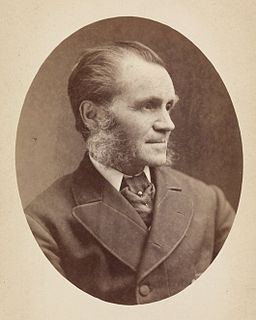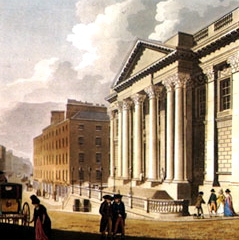
Gottfried Semper was a German architect, art critic, and professor of architecture who designed and built the Semper Opera House in Dresden between 1838 and 1841. In 1849 he took part in the May Uprising in Dresden and was put on the government's wanted list. He fled first to Zürich and later to London. He returned to Germany after the 1862 amnesty granted to the revolutionaries.

Philip Hardwick was an English architect, particularly associated with railway stations and warehouses in London and elsewhere. Hardwick is probably best known for London's demolished Euston Arch and its twin station, the original Birmingham Curzon Street, which stands today as the oldest railway terminus building in the world.

Joseph Aloysius Hansom was a British architect working principally in the Gothic Revival style. He invented the Hansom cab and founded the eminent architectural journal, The Builder, in 1843.
The year 1933 in architecture involved some significant architectural events and new buildings.
The year 1851 in architecture involved some significant architectural events and new buildings.
The year 1876 in architecture involved some significant architectural events and new buildings.
The year 1837 in architecture involved some significant events.
The year 1803 in architecture involved some significant architectural events and new buildings.
The year 1845 in architecture involved some significant architectural events and new buildings.
The year 1858 in architecture involved some significant events.
The year 1865 in architecture involved some significant architectural events and new buildings.
The year 1816 in architecture involved some significant architectural events and new buildings.

Joseph Reed, a Cornishman by birth, was a prolific and influential Victorian era architect in Melbourne, Australia. He established his practice in 1853, which through various partnerships and name changes, continues today as Bates Smart, one of the oldest firms continually operating in Australia.

Francis William Petre, sometimes known as Frank Petre, was a New Zealand-born architect based in Dunedin. He was an able exponent of the Gothic revival style, one of its best practitioners in New Zealand. He followed the Catholic Church's initiative to build places of worship in Anglo-Saxon countries inspired by Romance forms of architecture. His basilica Cathedral of the Blessed Sacrament, in Christchurch was demolished in 2021.
The year 1802 in architecture involved some significant events.

James Malton (1761–1803) was an Irish engraver and watercolourist, who once taught geometry and perspective and worked as a draughtsman in the office of the celebrated Irish architect James Gandon.
The year 1836 in architecture involved some significant events.
James Blackburn was an English civil engineer, surveyor and architect best known for his work in Australia, where he had been transported as a sentence for forgery. According to the Australian Dictionary of Biography, Blackburn "has claims to be considered one of the greatest engineers of his period in Australia, and his architectural achievements established him as Tasmania's most advanced and original architect." He was key to the formation of the Department of Public Works in 1839, serving as one of its core members under Alexander Cheyne.

Mill Hill Chapel is a Unitarian church in Leeds, West Yorkshire, England. It is a member of the General Assembly of Unitarian and Free Christian Churches, the umbrella organisation for British Unitarians. The building, which stands in the centre of the city on City Square, was granted Grade II* listed status in 1963.








